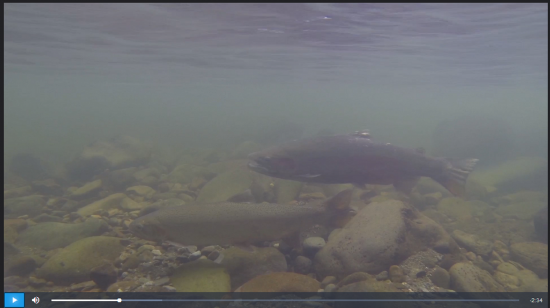
Willamette Wild Steelhead Rebound Continues
Without California sea lions intercepting them at the falls this winter, wild Willamette steelhead are making it upriver in numbers not seen so early in several years, helping to sharply reduce their risk of extinction.
And the cumulative Feb. 13 count of 1,650 fish points to what might come in as the largest return to the Western Oregon watershed since 2016.

“Things are a lot brighter for Willamette winter steelhead than they (were) in 2017,” said Dr. Shaun Clements, an ODFW senior policy analyst, yesterday afternoon.
That year, just 265 had been counted by Feb. 13 as California sea lions took a heavy toll. One day as many as 41 were spotted as they gathered below the falls to munch on salmonids.
Things looked so grim that there was an 89 percent chance that one of the watershed’s wild steelhead stocks would go extinct, state fishery managers estimated.
When counting wrapped up for the year, just 822 of the fish were tallied at Willamette Falls.
That sparked outrage and change. Following federal authorization to begin culling sea lions, ODFW took out 33 from December 2018 to May 2019.
Last April managers were buoyed by initial results, and on Tuesday Clements reported that no CSLs have visited the falls since last June.
“Typically we would start to see them in August and would have up to a dozen by now,” he said.
Without any, the fish are now getting a freer pass.
“This is the first year in a decade that the winter steelhead run has not been subject to predation at this time. We might otherwise have expected 300 to 400 of the 1,650 fish to have been eaten before passing the falls,” Clements said.
It’s possible the spring Chinook run up the Willamette will still draw some sea lions to the falls. It’s also possible they are just feeding elsewhere, perhaps focusing on smelt downsteam in the Columbia and Cowlitz.
ODFW has authority to kill as many as 93 California sea lions a year. Candidates for removal must be seen between the falls and the mouth of the Clackamas, which is just downstream, on two straight days, or be observed consuming Chinook or winter-runs there, according to the agency.

Yet while sea lion removals do appear to be having a “significant impact” in helping to rebound steelhead numbers, Clement said that that’s not the only factor at play.
This year’s fish apparently enjoyed a narrow window of better fresh- and saltwater conditions following the height of The Blob’s awful impacts on land and in the ocean.
Clements said that two-thirds of 2020’s steelhead are 4-year-olds that were the progeny of 2016’s run of 5,778, and they had “OK” and “very good” rearing conditions during their two years in the basin, respectively.
They also entered the sea in 2018 during a “brief respite” from the North Pacific’s marine heat waves, and that “likely contributes somewhat to the bump in returns we’re seeing at this point in the run,” he added.
To the north, this year’s Puget Sound wild steelhead haven’t been as lucky.
WDFW blamed “severe drought and low river flows in 2015 and 2016, as well as an unprecedented marine heatwave in the Pacific Ocean that negatively affected survival rates” on a Skagit-Sauk forecast that precluded opening the much-anticipated winter-spring catch-and-release fishery. An average of 45 percent of that run is comprised of 5-year-old steelhead.
Still, the early indications out of the Willamette represent a glimmer of hope in what has been a bummer season overall for Northwest steelhead.
Given improved environmental conditions, predator control can help boost returns above what they might otherwise be, getting more fish onto the gravel, key for Endangered Species Act-listed stocks like Willamette steelhead.
Clements said that sea lion predation rates have declined from 21 to 25 percent on 2018’s run to 7 percent on last year’s, and he expected it “to get close to 0 by next year.”

ODFW counts winter-runs at the falls through May.
Since 2010, by Feb. 13 the return has been anywhere from 15.2 to 36.6 percent complete. Plugging those percentages into 2020’s return of 1,650 so far yields a final range of roughly 4,350 to 10,700 fish, though that top end seems pretty unlikely, given performance last decade.
High marks over the past 10 years include 7,616 in 2012, 7,441 in 2011 and 7,337 in 2010.
Low marks include 2017’s aforementioned 822, 1,829 in 2018 and 3,202 in 2019.
The average is 5,610.
Cumulative Feb. 13 counts in the 2010s were:
2020: 1,650
2019: 487
2018: 579
2017: 265
2016: 1,875
2015: 1,539
2014: 840
2013: 1,278
2012: 2,788
2011: 2,711
2010: 2,395
The 10-year average is 1,401.
In late 2018, Congress granted Northwest states and tribes broader authority to remove California as well as Steller sea lions and last June ODFW, WDFW and other entities applied to the National Marine Fisheries Service for a permit to do so in portions of the Columbia above and below Bonneville Dam, plus salmon- and steelhead-bearing tributaries of the big river.




